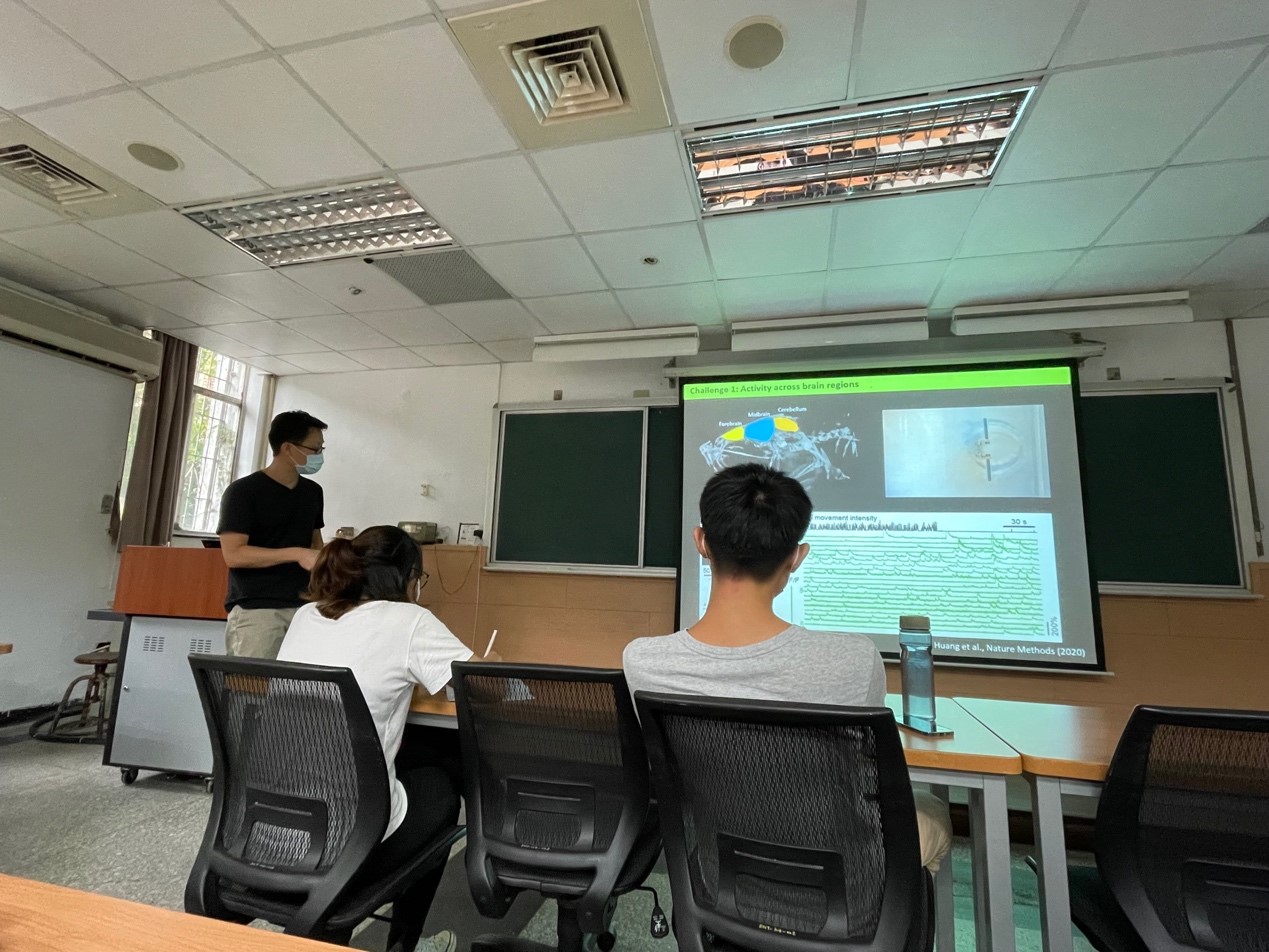A virtual reality system to study predictive neural processing during social interaction
編輯 (Editor): 林家揚、區嘉曦、黃冠瑋

演講者 (Invited Speaker) 黃國華 助理研究員 中央研究院分子生物研究所
主持人 (Host) 吳岳隆 教授 國立台灣大學昆蟲學系
演講日期 (Date):2021/10/12 (二) 11:20~12:20
課程之內容與新知
此次演講我們請到中研院的黃國華博士來為我們分享他的研究題目,黃博士目前主要使用虛擬實境系統研究社交行為中的預測神經處理,黃博士首先舉了幾個例子來說明大腦的預期行為,而後提出社會預測是一個重要的課題,因為這可以用於定義一些人類的品質,例如同理心,而缺乏做出預測的能力可能會導致精神疾病的發生。
而今天的演講分為兩個部份,第一部分為在研究社會預測的兩個挑戰,主要是方法的部份,第二部份則是如何使用這些工具來研究生物學。第一部分的挑戰為行為是複雜的,會涉及多個大腦的功能,而這些功能通常分佈在整個大腦之中,因此第一個挑戰為很難去同時監測大腦的活動,第二個挑戰則是很難去精準的控制社會刺激。
研究的材料黃博士選擇了斑馬魚,因為它的神經細胞數目較少,因此也較不複雜,能讓實驗快速進行,而在過去做的實驗方法可觀察分析魚尾巴的形狀,根據傾向哪一側,可以猜測他們的方向,並基於振盪頻率猜測他們希望的速度。但在研究VR中的社交互動方面,黃博士認為他們必須做到能讓真魚更準確的表達自已,然而這對之前的Fish VR來說並不容易,因此在中研院開發了一個使用6個方向軸的新型VR系統,該系統能使頭部受限的斑馬魚在3D虛擬實境中游動,並且同時監測過程中前腦的活動,這可以將反映情緒和視覺的神經活動連結。
在方法的部份黃博士已經可以做到,因此第二部分的問題是要如何使用新的方法對大腦進行研究,黃博士決定將討論重點放在預測的社會行為,由於預測行為是通過學習獲得,因此設計了不同的實驗來驗證,其中一項為將虛擬魚分為三種不同類型,對真魚有不同的行為,預期真魚會將行為與預告訊號做出連結,這是一個理想的結果,而這和控制學習和社會行為的神經迴路有密切關係,而黃博士最新的目標是從計算神經科學的層面來了解人類自閉症的成因。
Q&A
Q1: 謝謝老師的演講,現在看起來已經能夠定義斑馬魚怎樣的動作,代表怎麼樣的意思。而現在大部分的實驗都是用虛擬實景的方式進行,那有沒有可能利用真實的斑馬魚,研究斑馬魚看到同類哪一些動作會作出怎樣的反應呢?
A1: 可以。在真實的飼養環境中,我們可以分析魚群之間不同的反應,這些研究都有人在做。這些研究很重要,因為它可以告訴我們那一些行為參數是重要的,而這些參數可以運用在建模上面。透過這些參數及反應,我們可以建立一個更「真實」的虛擬實景應用到研究上。
Q2: I have three questions. So, the first question is I am curious about what the “fish see” just as we “human see” on the screen? The second question is it seems that the samples that you’re using on the experiment are the adult, but why not using juvenile? I suppose that just like the human being on young people have better learning abilities. About the third question, to feedback the last part of your talk, it’s about the genes and the behavior now is the error. However, you are talking about one gene, so you found that they are some links in between the gene and the autism. I suppose that it is not only one gene lead to be disease, there are many genes work together. So, how do you joint the markable gene on your experiment design? Thanks!
A2: about the first question, the fish is actually quite similar to human eyes. For example, human eyes can see the three primary colorsthat is available for fish. Also, in terms of light intensity we use rode cell and it is also available in fish. Therefore, the basis color channels are available for fish. Spatial resolution is another issue to consider. Scientists have used moving gratings of different spatial resolution to test the fish’s visual acuity. Finally, refresh rerate should be considered and our monitor used in experiment is the regular 60 Hz. About the second question, there is a trend to study juvenile fish. But the problem with using juvenile fish is that their learning and social capacity are not as robust as adult animals. On the third question, now we only study one gene. Actually, there are more than 500 genes associated to autism through the genome-wide association study. Yes, we only study one gene, and if we see that the error signal is increased we will test another gene mutation. If there is a trend that autism related mutation cause a similar phenotype on computation, this is a strong implication of the cause of autism at the level of neural computation.
Q3: Did the complexity of the brain increase in proportion to the brain size? So, the development of zebrafish brain is quite different from human brain.
A3: Yes, the structure is very different from them. For example, the cortex of human has six layers, but the central zone of the dorsal telencephalic area in fish doesn’t have layers. Some brain research will use mammals, such as mice. Even so, the brain structure of mice is still different from that of humans. They have no folding in their cortex. You can always find the different between animal and human brains.
Q4: I wonder how to define the level of social interaction and why you choose to use virtual reality (VR)?
A4: Because it is easy to control. I have mentioned two parts we can control. One is the correlation of tail movement; One is the correlation of orientation. Because these two correlations are easy to quantify. Also, there are other data can be analyzed, such as the color of the zebrafish body and the movement of their fins.
花絮照片 (other photos) 3 ~ 5張




